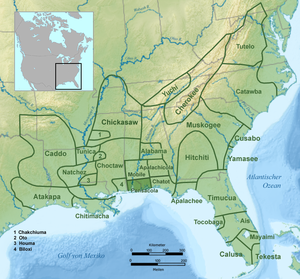Pensacola (people)
The Pensacola , also Panzacola , were a North American Indian people who lived at the beginning of European contact in northwestern Florida , the so-called Panhandle ( panhandle ), and in southeastern Alabama . They spoke a dialect of the Muskogee languages , probably similar to that of the Choctaw . Your name comes from this language and basically means people with hair . Pensacola Bay and the city of Pensacola are named after them. The Pensacola lived in this area until the middle of the 18th century, after which they joined neighboring peoples and their existence as a tribe is considered extinct since around 1760.
Culture
The Pensacola developed a culture that archaeologists refer to as the Pensacola culture . It is considered a regional variant of the Mississippi culture and existed from 1100 to 1700 AD. Archaeological excavations show that this culture was widespread in its heyday from Choctawhatchee Bay in the east to the Mississippi River Delta near Biloxi in the west. Most discoveries services excavations in the area of Mobile Bay and the delta of Mobile and Tensaw River . The area extended north to the southern valleys of the Tombigbee River and Alabama River , approximately to the city of Selma , Alabama . Probably the most famous site of the Pensacola culture is the Bottle Creek site on a flat, swampy island north of Mobile , Alabama. This facility has at least eighteen flattened mounds , five of which are arranged around a rectangular square. The place was particularly heavily populated from 1250 to 1550. It was the ceremonial center for the Pensacola population, but it was surrounded by swamps and difficult to reach on foot. Access was therefore by means of dugout canoes , the most important means of transport for the residents of the Bottle Creek facility.
history
The first contact between the Pensacola and Europeans was probably made by the Narváez expedition in 1528. Cabeza de Vaca reported that the residents of Pensacola Bay were "handsome and well-formed" and lived in solid houses. The Kazike wore a coat made of marten fur, the best fur there was. Although the Indians appeared peaceful at first, they attacked the Spaniards during the night without warning.
In 1539 Diego Maldonado explored the north coast of the Gulf of Mexico on the orders of Hernando de Soto and discovered the Pensacola Bay, which was named differently by the Spaniards: Achuse, Achusi, Ochuse or Ochus Bay. Maldonado found a village on the bay and had two residents, dressed “with a sable blanket”, arrested. De Soto ordered Maldonado to meet him at Achuse Bay the next summer to pick up supplies for his expedition. Maldonado went to the bay three years in a row, but de Soto never arrived.
In 1559, Tristán de Luna y Arellano led an expedition to found the Spanish colony of Ochuse on Pensacola Bay. The Spaniards had decided to get the food from the Indians. But the whole area was deserted and they found only a few indigenous people fishing in the bay. In the next time the colony lost hundreds of colonists due to bad weather, hunger and disease. The survivors eventually escaped to Cuba and Mexico .
In 1657 the name Pensacola was first mentioned in Spanish documents as Panzacola or Pansacola . It referred to an Indian village near the Mission San Juan de Aspalaga in the tribal area of the Apalachee. In 1685, the Spanish were concerned about French plans to establish their own colony on the Gulf Coast. The following year, the Spaniards searched in vain for the announced French colony and for a suitable place for a Spanish colony to secure their interests in the region. When Juan Jordan de Reina reached the bay in 1686, he found a tribe of Indians who called themselves and the bay Panzacola . In 1688, participants in another Spanish expedition reported large, flourishing villages with friendly and docile Indians. Two expeditions from 1693, from Veracruz in New Spain and from Apalachee, reported an almost deserted area in the area of Pensacola Bay, the inhabitants of which were probably exterminated in a war with the neighboring Mobile . John Reed Swanton, on the other hand, claimed that the Pensacola were not killed but moved westward into the interior.
In 1698 the Spanish colony of Pensacola and a fort of the same name were founded in Pensacola Bay. The governor of Pensacola sought the support of the indigenous people in the defense of the new colony. So he met with some of the Pensacola and Chacato people to persuade them to move their villages closer to Pensacola Bay. Around 1707 only a few Indians from the Ocataze tribe lived near the Spanish fort. In 1725 or 1726 there was a joint village of Pensacola and Biloxi on the Pearl River with about 40 men. The last mention of the tribe is on December 1, 1764, when an estimate was made of the indigenous population in the region. After that, the Biloxi, Capinan, Chatot, Chawasha, Pascagoula, Pensacola, and Washa had a total of 251 men. Most of the Pensacola were probably absorbed by the Choctaw after 1764 , while the rest moved to Louisiana and were integrated there by either the Tunica-Biloxi or the Muskogee.
Individual evidence
- ^ Extinct Pensacola Indians. Retrieved January 26, 2017 .
- ↑ a b c d Judith Anne Bense: Archeology of colonial Pensacola . University Press of Florida, Gainesville, Florida 1999, ISBN 0-8130-1661-4 . found in google books
- ↑ a b c d e Pensacola Indians. Retrieved January 25, 2017 .
